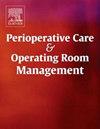Analysis of the effect of ergonomic factors on the performance of the operating room team with ANP
Q2 Nursing
Perioperative Care and Operating Room Management
Pub Date : 2025-07-21
DOI:10.1016/j.pcorm.2025.100530
引用次数: 0
Abstract
Purpose
The unit with the largest share of income and expense items in hospitals is the operating rooms. Therefore, operating rooms are expressed as the most critical units of hospitals. The performance of the personnel working in these units is vital as it directly affects patient health. The inefficient organization of operating rooms poses ergonomic risks. These ergonomic difficulties cause illnesses or injuries in the surgical team. For healthcare professionals to provide the highest quality of care to patients, their physical health should not be overlooked. Additionally, a poor work-life balance within the surgical team can lead to burnout and negatively impact the quality of life. Therefore, this study addresses the effect of ergonomic factors in operating rooms on the performance of the surgical team.
Methods
In the study, eleven sub-criteria were identified through a literature review and an expert group, and these criteria were subsequently evaluated using the Analytical Network Process (ANP) method, a multi-criteria decision-making approach.
Results
It has been determined that the most important ergonomic factor affecting the performance of the surgical team is the working conditions criterion.
Conclusion
Suggestions were made based on the results obtained from the evaluation.
人机工程学因素对ANP手术室团队绩效的影响分析
目的医院收入和费用项目占比最大的单位是手术室。因此,手术室被表达为医院最关键的单位。在这些单位工作的人员的表现至关重要,因为它直接影响到患者的健康。手术室的低效组织构成了人体工程学风险。这些人体工程学上的困难会导致外科团队患病或受伤。医疗保健专业人员为患者提供最高质量的护理,他们的身体健康不应被忽视。此外,手术团队中工作与生活的不平衡会导致倦怠,并对生活质量产生负面影响。因此,本研究探讨手术室人机工程学因素对手术团队绩效的影响。方法在研究中,通过文献综述和专家组确定了11个子标准,随后使用分析网络过程(ANP)方法对这些标准进行评估,这是一种多标准决策方法。结果确定了影响手术团队工作表现的最重要的人机工程学因素是工作条件标准。结论根据评价结果提出建议。
本文章由计算机程序翻译,如有差异,请以英文原文为准。
求助全文
约1分钟内获得全文
求助全文
来源期刊

Perioperative Care and Operating Room Management
Nursing-Medical and Surgical Nursing
CiteScore
1.30
自引率
0.00%
发文量
52
审稿时长
56 days
期刊介绍:
The objective of this new online journal is to serve as a multidisciplinary, peer-reviewed source of information related to the administrative, economic, operational, safety, and quality aspects of the ambulatory and in-patient operating room and interventional procedural processes. The journal will provide high-quality information and research findings on operational and system-based approaches to ensure safe, coordinated, and high-value periprocedural care. With the current focus on value in health care it is essential that there is a venue for researchers to publish articles on quality improvement process initiatives, process flow modeling, information management, efficient design, cost improvement, use of novel technologies, and management.
 求助内容:
求助内容: 应助结果提醒方式:
应助结果提醒方式:


